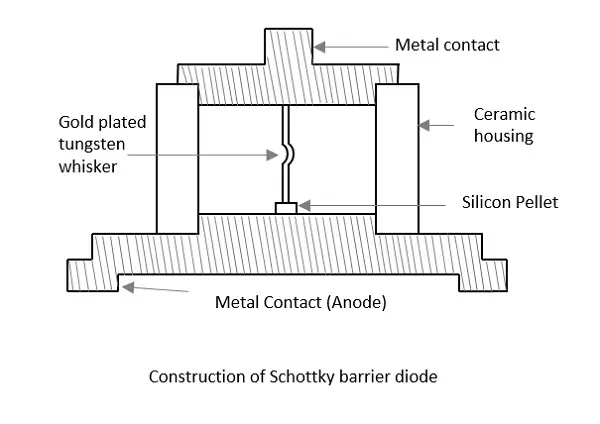
 Data Structure
Data Structure Networking
Networking RDBMS
RDBMS Operating System
Operating System Java
Java MS Excel
MS Excel iOS
iOS HTML
HTML CSS
CSS Android
Android Python
Python C Programming
C Programming C++
C++ C#
C# MongoDB
MongoDB MySQL
MySQL Javascript
Javascript PHP
PHPPhysics
Chemistry
Biology
Mathematics
English
Economics
Psychology
Social Studies
Fashion Studies
Legal Studies
- Selected Reading
- UPSC IAS Exams Notes
- Developer's Best Practices
- Questions and Answers
- Effective Resume Writing
- HR Interview Questions
- Computer Glossary
- Who is Who
Explain the construction and working of a Microwave Schottky Barrier diode.
This is a simple diode that exhibits non-linear impedance. These diodes are mostly used at microwave detection and mixing.
Construction
A semi-conductor pellet is mounted on a metal base. A spring-loaded wire is connected with a sharp point to this silicon pellet. This can be easily mounted into coaxial or waveguide lines. The below figure gives a clear picture of this.

Operation
With the contact between semiconductor and the metal, a depletion region is formed. The metal region has a smaller depletion width, comparatively. When contact is made, electron flow occurs from semi-conductor to the metal. This depletion builds up a positive space charge in the semiconductor and electric field opposes further flow, which leads to the creation of a barrier at the interface.
During forward bias, the barrier height is reduced and electrons get injected into the metal whereas in reverse bias, the barrier height gets increased and the electron injection almost stops.
Advantages
These are the following advantages
- Low cost
- Simplicity
- Reliable
- Noise figures around 4 to 5dB
Applications
These are the following applications
- Low noise mixer
- The balanced mixer in continuous wave radar
- Microwave detector

